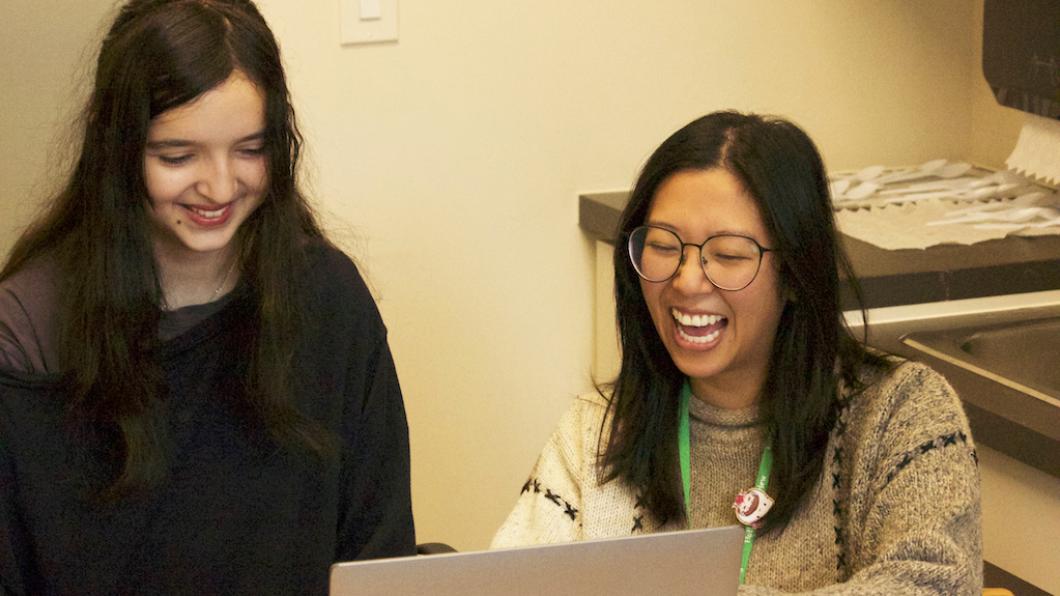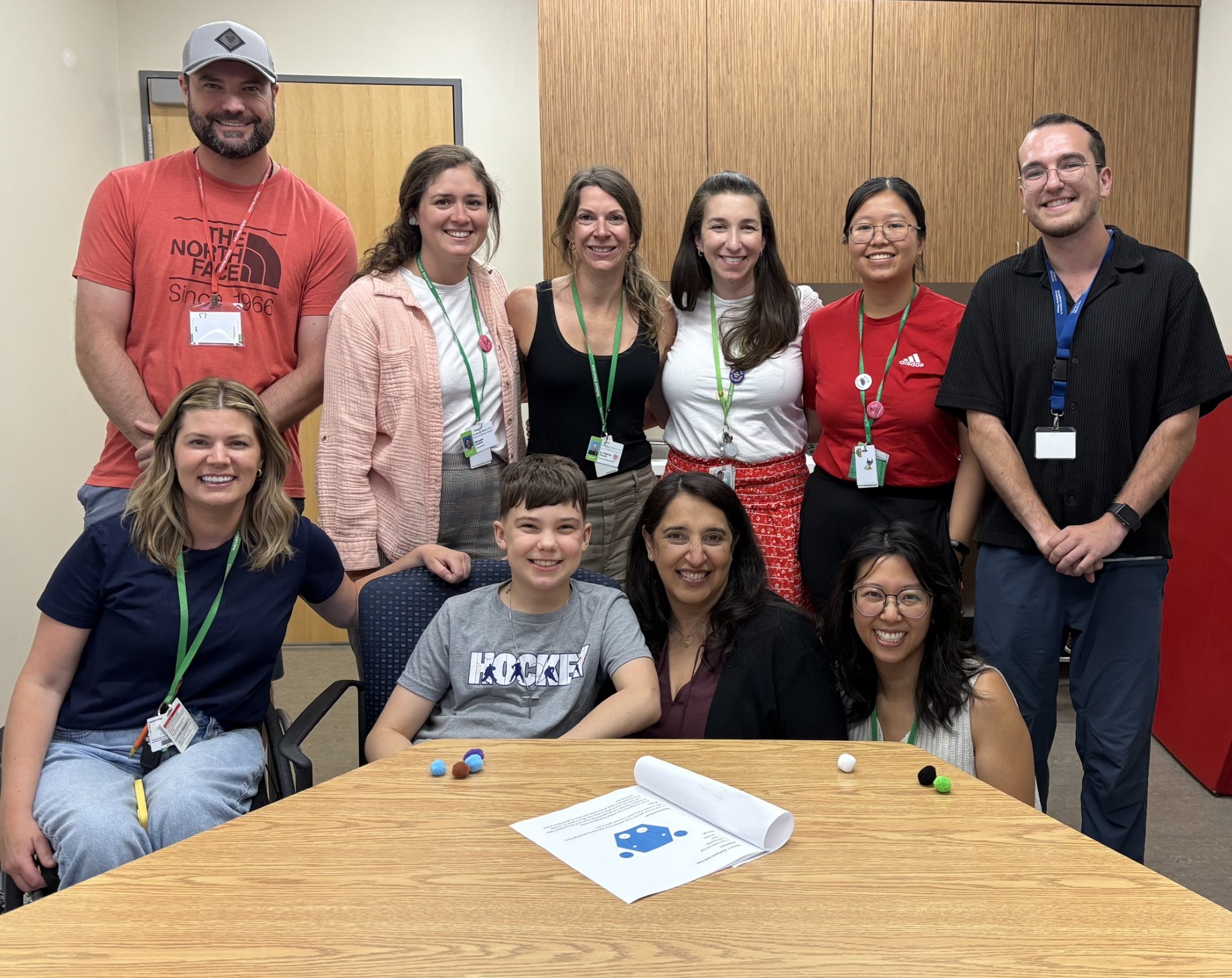
Clinician tailors therapy to light each child's spark
By Louise Kinross
Maria Wong (above right) is a speech-language therapist at Holland Bloorview who works with children with brain injuries caused by illness or trauma. She's known for homing in on a child’s passions and identifying what lights them up. For example, a boy who adored cars did therapy while adapting a bike to look like a pick-up truck. To engage other children, she’s organized hockey scrimmages between families and clinicians, encouraged playful pranks on staff, and even built an escape room. Wong recently received Jake’s Award, which honours a hospital clinician. She was nominated by her team and Brady (in grey shirt below) who said: “She is really nice, really creative and really fun!”
BLOOM: How did you get into this field?
Maria Wong: My parents suggested it. Then I was drawn into speech-language therapy when I volunteered with the March of Dimes as an undergraduate. I worked with people who had experienced a stroke or brain injury and had aphasia. They had trouble understanding language or speaking. Communication is so key to connection and having a sudden loss of being able to connect in a way you normally would causes a big shift in identity. I wanted to help in any way possible.
BLOOM: How do you work with children here?
Maria Wong: My favourite way to do therapy is to do joint sessions with an occupational or physical therapist or a social worker. Brain injury doesn’t just affect one area.
Working with other therapists allows us to support the child in the most holistic way. Let’s say a child is very emotional and sharing their feelings. It’s not within my realm to support that, but a social worker can, and I can help the child to get their ideas out. Working with a physiotherapist is great for a little one who doesn’t want to sit with me but to move around. I find when we work together, we do our best work.
BLOOM: What’s the greatest challenge of working with children with acquired brain injury?
Maria Wong: I think the hardest is not being able to give the family all the answers to their questions. Often we don’t know how the child will be affected. We have to learn to sit with the uncertainty. I don’t want to be dishonest with a family. I want to be true and see their experience for what it is. If it involves sitting with uncertainty, then I will sit with them so they don’t feel alone.
The other challenge is burnout. There isn’t enough time in a day to do everything we want to do. If there were more resources, there would be more time. COVID led to a big shift in our team. A lot of people retired, and due to distancing, we were separated in our work. Even though we’re past COVID, we haven’t had time to really reflect on and understand its impact on us. We want to do our best and when we feel like we can’t, it’s disappointing and frustrating.
BLOOM: What are the greatest joys?
Maria Wong: One of my most favourite things is working with my team. I love them so much and feel I can do my best work with them. The other is when I finally find ‘the thing’ that resonates and matters for each child and can run with it. That brings me so much joy.
BLOOM: What qualities do you need to be good at your job?
Maria Wong: An openness to not always knowing, and a willingness to keep learning. Our work is not one-size-fits-all. A client might have the same diagnosis as someone else, but we never impose anything on that new client. We take our experience and knowledge but also, in the moment, we need to learn from the new person: ‘Who are you? How can I help you?’
BLOOM: How do you come up with such unique ways of working with each child?
Maria Wong: In the beginning, building rapport is one of my biggest goals. It takes time to build trust with a child, so you can get to know them and their interests. Sometimes I ask parents about what they most enjoy. When I see that spark in a child, I know that's what we're going to do.
For example, Brady enjoyed spending time with his family and playing sports. So we came up with the idea for a Minute to Win It event that his family would play vs. the therapy team. They had to complete different games, like blowing pom poms into a cup across the table or rolling dice and grabbing that number of marshmallows with mini clamps. Brady planned the events, created a manual for the game instructions, and led the activities that day.
BLOOM: What emotions come with the job?
Maria Wong: So many. Imposter syndrome. I’ll think ‘Oh gosh, am I the right person to help this client?’ That kind of doubt comes and goes.
There’s a lot of worry. I really hope that I’m helping.
There’s so much joy when I see how happy a child is, and pride for them when they accomplish things. I have a sense of appreciation when we see progress and gratitude to everyone who is involved.
Then there’s stress. I’m behind on my paperwork. It’s very real and one of the things I’m not the most fond of. It piles up and there isn’t enough time for everything.
BLOOM: How do you manage stress?
Maria Wong: It’s an ongoing journey for me. What’s changed is that I’m a mom now, balancing being a mom and doing a full-time job. My son is four and just started kindergarten, so we’re in a new chapter. I try to practice being present, being mindful. When I’m at home I want to be present for the small joys with my husband and son. Our jobs give us perspective on what’s important. I also found seeing a therapist helpful for recognizing when I’m stressed out. There was such a disconnect before, when I didn’t recognize how stressed I was.
BLOOM: If you could change one thing about how we support families of children with brain injury, what would it be?
Maria Wong: I wish we had more time with each family in a day. I’m talking about more time to slow down. To do a session but have a moment after to debrief and ask: ‘How did that feel for you?’ More time to check in with the family and have them reflect on whether I’m on the right path. If I’m not, I can course correct, and if I am, I will continue.
I want to make sure their voices are heard. So much in their journey is dictated to them. We’ll see you this many times a week, at these times, and I’ll only see you for this amount of time. We need more time to check in on what will work best for the family. That’s the only way we can truly be client- and family-centred.

Like this content? Sign up for our monthly BLOOM e-letter, follow BLOOM editor @LouiseKinross on X, or watch our A Family Like Mine video series.